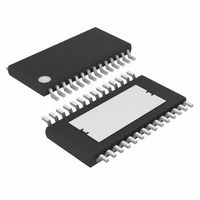MAX5051AUI+ Maxim Integrated Products, MAX5051AUI+ Datasheet - Page 15

MAX5051AUI+
Manufacturer Part Number
MAX5051AUI+
Description
IC PWR SPLY CNTRLR 28-TSSOP
Manufacturer
Maxim Integrated Products
Datasheet
1.MAX5051AUI.pdf
(21 pages)
Specifications of MAX5051AUI+
Pwm Type
Voltage Mode
Number Of Outputs
1
Frequency - Max
500kHz
Duty Cycle
48%
Voltage - Supply
11 V ~ 76 V
Buck
No
Boost
Yes
Flyback
Yes
Inverting
No
Doubler
No
Divider
No
Cuk
No
Isolated
Yes
Operating Temperature
-40°C ~ 125°C
Package / Case
28-TSSOP Exposed Pad, 28-eTSSOP, 28-HTSSOP
Frequency-max
500kHz
Lead Free Status / RoHS Status
Lead free / RoHS Compliant
in control. Thus, the output-voltage slew rate is constant
at light or heavy loads. Once the soft-start ends, the
voltage on CSS regulates to 1.24V. Do not load CSS
with external circuitry. A suitable range of capacitors
connected to CSS is from 10nF to 0.1µF. Calculate the
required soft-start capacitor based on the total output-
voltage startup time as follows:
where C
the soft-start time required for the output voltage to rise
from 0V to the rated output voltage. This only applies
when this amplifier is used for output voltage regulation.
The PWM ramp is generated at RCFF. Connect a
capacitor C
R
RCFF is internally offset by 2.3V and applied to the non-
inverting input of the PWM comparator. The slope of the
ramp is part of the overall loop gain. The dynamic
range of RCFF is 0 to 3V, and so the ramp peak must
be kept below that. Assuming the maximum duty cycle
approaches 50% at minimum input voltage, use the fol-
lowing formula to calculate the minimum value of either
the ramp capacitor or resistor:
where V
(typically the PWM UVLO turn-on voltage), f
switching frequency, and V
ramp voltage, typically 2V.
Allow the ramp peak to be as high as possible to maxi-
mize the signal-to-noise ratio. The low-frequency small-
signal gain of the power stage, Gps (the gain from the
inverting input of the PWM comparator to the output)
can be calculated by using the following formula:
where N
former turns ratio.
The MAX5051 has two internal linear regulators that are
used to power internal and external control circuits. The
9V regulator, REG9, is primarily used to power the high-
RCFF
from RCFF to AVIN. The ramp generated on
CSS
INUVLO
sp
RCFF
is the secondary-to-primary power trans-
is the capacitor connected to CSS, t
G
R
ps
is the minimum input supply voltage
C
RCFF RCFF
from RCFF to ground and a resistor
______________________________________________________________________________________
CSS
=
N R
C
=
sp RCFF RCFF s
56
µ
F s t
≥
RPP
/
Internal Regulators
V
2
C
×
INUVLO
f V
Parallelable, Clamped Two-Switch
s RPP
is the peak-to-peak
SS
f
PWM Ramp
S
is the
Power-Supply Controller IC
SS
is
and low-side gate drivers. Bypass REG9 with a 4.7µF
ceramic capacitor or any other high-quality capacitor;
use low-value ceramics in parallel as necessary. A 5V
regulator also is provided, REG5, primarily used to bias
the internal circuitry of the MAX5051. Bypass REG5 with
a 4.7µF ceramic capacitor similar to the one used for
REG9. Both of these regulators are always powered.
When using bootstrapped startup through a bleed resis-
tor, do not load these outputs while the MAX5051 is in
standby as it may fail to start. Any external loading to
this output should be such that the sum of their load and
the standby current through PVIN of the MAX5051 is
less than the current that the bleed resistor can supply.
The MAX5051 can be configured for two different
startup modes, allowing operation in either boot-
strapped or direct power mode.
In direct power mode, AVIN and PVIN are connected
directly to the input supply. This is typical in 12V to 24V
systems. The undervoltage lockout set at STT needs to
be adjusted down with an external resistor-divider to an
appropriate level.
In bootstrap mode, a resistor is connected from the
input supply to PVIN, where a capacitor to GND is
charged towards the input supply. When this voltage
reaches the startup threshold, the device wakes up and
begins switching. A tertiary winding from the trans-
former is then used to sustain operation. The MAX5051
draws little current from PVIN before reaching the
threshold, which allows a large-value bootstrap resistor
and reduces its power dissipation after startup. A large
startup hysteresis helps the design of the bootstrap
circuit by providing longer running times during startup.
After coming out of standby and before initiating the
soft-start, the MAX5051 turns on the low-side FET to
charge up the boost capacitor. A voltage detector has
been incorporated in the high-side driver that prevents
the high-side switch from turning on with insufficient
voltage. It is also used to indicate when the boost
capacitor has been charged. Once the capacitor is
charged, soft-start commences. If the duty cycle is low,
the magnetizing energy in the transformer may be
insufficient to keep the bootstrap capacitor charged.
DRVB (see Figure 2 dotted lines) has been provided to
drive a small external FET connected between
XFRMRH and PGND, and is pulsed every cycle to keep
the capacitor charged.
Bootstrapped Startup
Direct Power Mode
Startup Modes
15












